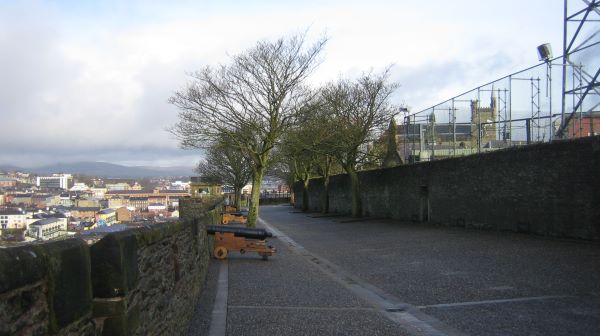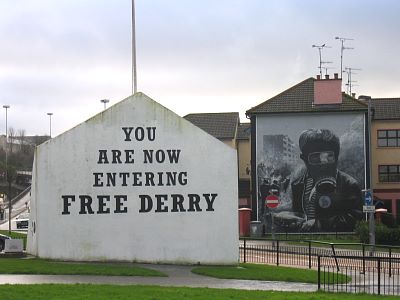A week at the University of Ulster Magee
 Derry, Northern Ireland
Derry, Northern IrelandThis was my first trip as a visiting professor to the University of Ulster, Magee campus -- although I came here last year for one day. It was outside of term-time, so attendance at my workshops was voluntary, but I got a pretty good crowd on most days. Almost all of the students were first-years, with one or two second-years as well. I gave my Fundamentals and Character Design workshops, as well as a new one that I created just for them, an introduction to game balancing. As with most of my workshops, it didn't need a computer. I created a deliberately unbalanced card game for two people, then let them play it and propose new rules to correct it.
I also got a chance to be a tourist for a bit. Derry, or Londonderry, is a fascinating city. The official name is Londonderry because the current city was built by London companies in the 1600s on lands confiscated from local Irish landowners, but the original name of the region was Derry, and Irish nationalists prefer the older term. The city walls are still intact -- the only complete city wall remaining in Europe, they say -- and I took an hour or so to walk all the way around them, even though it was chilly and raining a little. They've even got the original cannon (although on new carriages). Derry's nickname is "The Maiden City" because it outlasted at least two great sieges and was never taken.

Derry is also famous for less happy reasons -- the Troubles of Northern Ireland. For a couple of centuries the region outside the city walls was known as the Bogside, a depressed area inhabited by poor and disenfranchised Catholics. In 1969 this was the scene of a huge multi-day riot called the Battle of the Bogside,
 and for almost three years the Bogside was a self-policing, autonomous region known as "Free Derry." The Bogside has since been redeveloped, and a number of monuments and murals commemorate those events. It's now a place of pilgrimage for civil rights activists and many others. The mural in this photo shows a young boy in a gas mask and holding a Molotov cocktail. Some of the newer murals now celebrate peace rather than confrontation.
and for almost three years the Bogside was a self-policing, autonomous region known as "Free Derry." The Bogside has since been redeveloped, and a number of monuments and murals commemorate those events. It's now a place of pilgrimage for civil rights activists and many others. The mural in this photo shows a young boy in a gas mask and holding a Molotov cocktail. Some of the newer murals now celebrate peace rather than confrontation.

